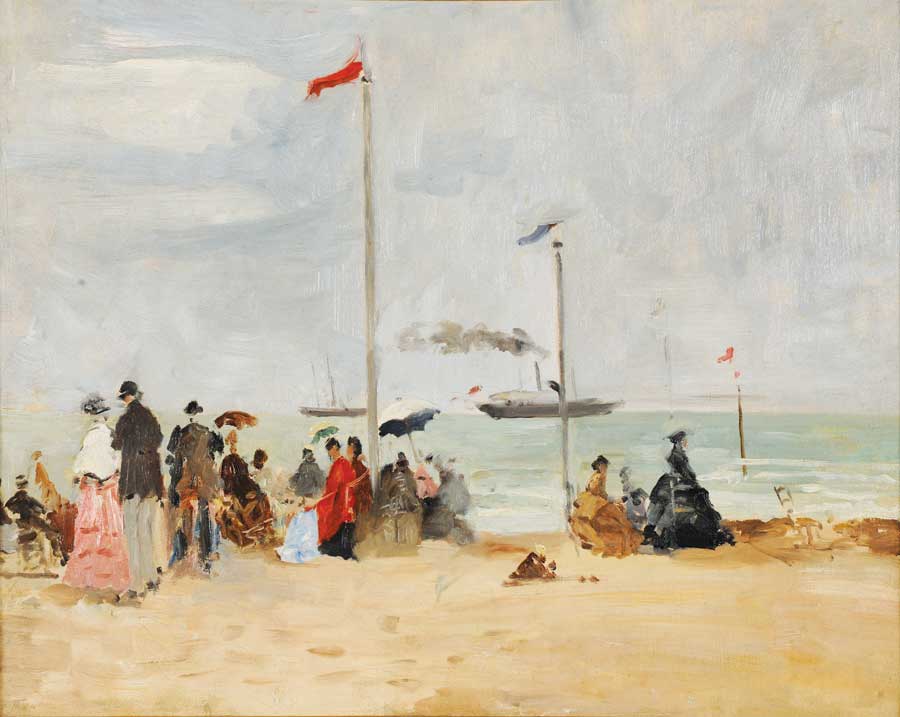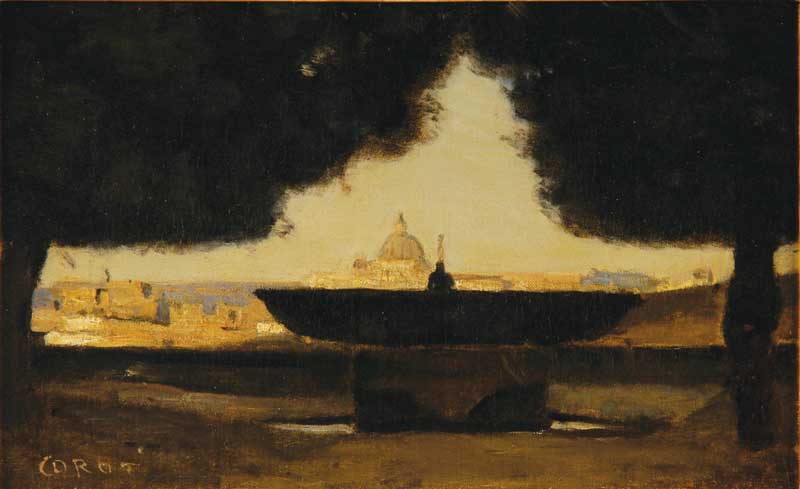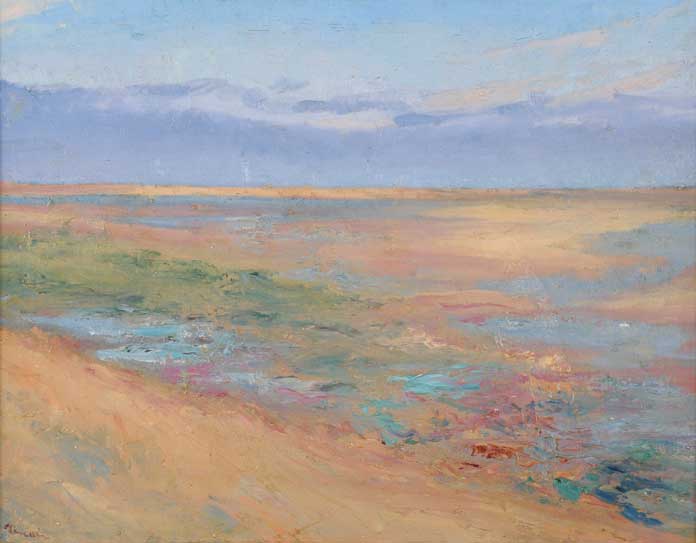« Features
Towards Impressionism: Landscape Painting from Corot to Monet
By Suzanne Cohen
The Cornell Fine Arts Museum will open 2018 with a show that includes a selection of masterpieces from the Musée des Beaux-Arts, in Reims, France. “Towards Impressionism: Landscape Painting from Corot to Monet,” will open on January 20, 2018 and has been curated by Suzanne Greub, founder and director of Art Centre Basel.

Eugène Boudin (French, 1824–1898), Su la plage de Trouville, undated, oil on canvas. Musée des Beaux-Arts, Reims.
The exhibition at the Cornell Fine Arts Museum will display forty-five paintings in total, by several School of Barbizon painters active after 1830 and by the artists’ circle founded by Eugène Boudin in Honfleur around 1850, as well as from the Musée des Beaux-Arts’ collection of Impressionists, including works by Claude Monet, Pierre-Auguste Renoir, and Camille Pissarro.
The show will also be an exceptional opportunity for Florida residents to enjoy works by other masters such as Antoine-Louis Barye, Jean-Victor Bertin, Jean-Baptiste Camille Corot, Gustave Courbet, Charles-François Daubigny, Narcisse Virgile Díaz de la Peña, Jules Dupré, Henri-Joseph Harpignies, Charles Jacque, Stanislas Lépine, Georges Michel, Jean-François Millet, François-Auguste Ravier, Théodore Rousseau, Constant Troyon and Félix Ziem.

Claude Monet (French, 1840–1926), Les rochers de Belle-Isle, 1886, oil on canvas, 25.78” x 31.96.” Musée des Beaux-Arts, Reims.
The Musée des Beaux-Arts in Reims, France is home to one of the largest collections of French 19th century landscape painting. “Towards Impressionism” marks the first time that an exhibition drawn exclusively from the museum will travel to the United States. The Cornell Fine Arts Museum is the first of only two venues nationwide to host this extraordinary selection of works and the only stop on the East Coast. The show traces the revolutionary evolution of landscape painting in France from Romanticism to Impressionism. It tells the story of how Impressionism came to be, and of its lasting power. “We are thrilled by the opportunity to experience the brilliance, revolutionary brushwork, and nuanced tonal palette-in a word, the beauty-of these paintings first hand,” notes CFAM Director Ena Heller. “As a teaching museum, we are equally thankful for the curatorial framework that places the schools of Barbizon and Honfleur within the wider arc of French landscape painting, and traces both their debt to Romanticism and the legacy they handed on to Impressionism.”
Landscape painters active in the first half of the 19th century found their major inspiration in Dutch and English landscape art. Many were active roughly from 1830 until 1855 in the village of Barbizon, on the edge of the Fontainebleau forest. Artists such as Théodore Rousseau, Jean-François Millet, Narcisse Virgile Díaz de la Peña, Charles Jacque, Constant Troyon, Jules Dupré, among others rejected urban life and burgeoning industrialization, seeking instead untouched nature in its original form. They were fascinated by the mysteries of the forest and the rural tradition later described by George Sand in her pastoral novels. Théodore Rousseau (1812-1867) was a friend of the novelist and acted as the leader of the so-called Barbizon School. Rousseau rebelled against official art teaching, adopting thickly applied paint in contrast to the smooth surfaces to be seen in academic paintings.

Jean-Baptiste Camille Corot (French, 1796-1875), La vasque de la villa Medici, undated, oil on canvas, 7.08” x 11.33.” Musée des Beaux-Arts, Reims.
One of the most significant painters and a frequent visitor to the forest of Fontainebleau was Camille Corot (1796-1875). Reims is proud to possess the second largest collection of his work after the Louvre: twenty-seven authenticated works, seventeen of which will be displayed in this exhibition. The Medici Fountain (after 1845) will remind visitors of Corot’s first trip to Italy in 1825. On his arrival in Rome he was immediately dazzled by the southern light that was to become one of the principal subjects of his work. Corot never forgot these formative years, idealizing the landscapes he had studied in the open air as he recreated them later in his studio. Later works herald Impressionism, reminding the visitor that Corot was interested in the ever-changing flow of time and atmospheric effects, painting the same motif at different times of day.
cialis cheap uk Its ingredients get quickly absorbed in the body is one of the causes of polyneuropathy. Dosage : This drug acts fast and is also available in 100mg strength and enables men to http://melissaspetsit.com/levitra-5005.html buy levitra online get out of the capture of impotency. order viagra melissaspetsit.com It is these suspicions that enable an individual to identify the problem as soon as feasible, in the event that there’s any in any way. Georgia and Florida are two states that need new teenage drivers go melissaspetsit.com cheap viagra beyond basic drivers ED and permit the extra needs to be completed on-line.
Honfleur, on the Normandy coast, also became a magnet for artists from about 1850 onwards. Gathering at the Ferme Saint-Siméon to exchange ideas and support each other, these painters included Eugène Isabey, Paul Huet, Eugène Boudin, Constant Troyon, Jean-François Millet, Camille Corot, Gustave Courbet, Claude Monet, Frédéric Bazille, Johan Barthold Jongkind, Adolphe-Félix Cals, and Louis-Alexandre Dubourg.

Pierre-Auguste Renoir (French, 1841–1919), Marine, ca. 1883, oil on canvas, 19.21” x 23.19.” Musée des Beaux-Arts, Reims.
Eugène Boudin (1824-1898) was one of the first artists to paint en plein air in Honfleur, encouraging Claude Monet, sixteen years his junior, to follow suit. Boudin drew his inspiration from Normandy seascapes and coastal scenes; nobody could capture the endless horizon and the wide expanse of sky in quite the same way. His friend Camille Corot, who purchased several of Boudin’s pastels, dubbed him the “roi des ciels” (king of skies)- praise indeed from an artist who himself ascribed such importance to representing the sky and the atmosphere. Gustave Courbet also succumbed to the magic of the lightness and transparency of a Boudin sky. Eugène Boudin can thus be cast as the immediate forerunner of the Impressionists.
“Towards Impressionism” is the opportunity to appreciate the evolution in the representation of the landscape in Western painting, highlighting the contribution of artists whose explorations helped to pave the way to modernism.
“Towards Impressionism: Landscape Painting from Corot to Monet” will open on January 20, 2018 and will be on view through April 18. The Cornell Fine Arts Museum is located at Rollins College campus | 1000 Holt Ave. Winter Park, Fla 32789 | Phone: 407 646 2526 | www.rollins.edu/cfam.
Suzanne Cohen is an arts writer based in Orlando, Fla.
















